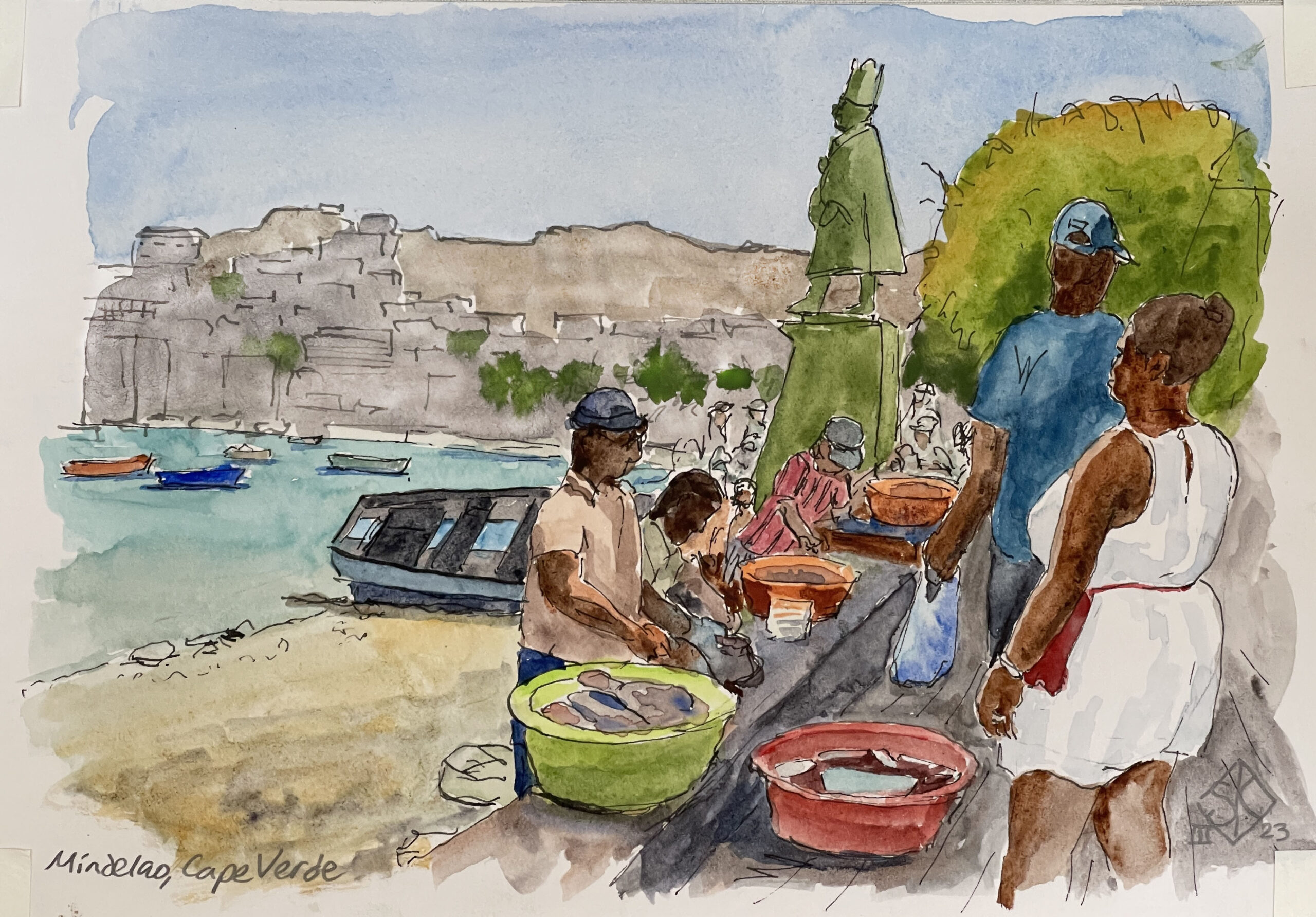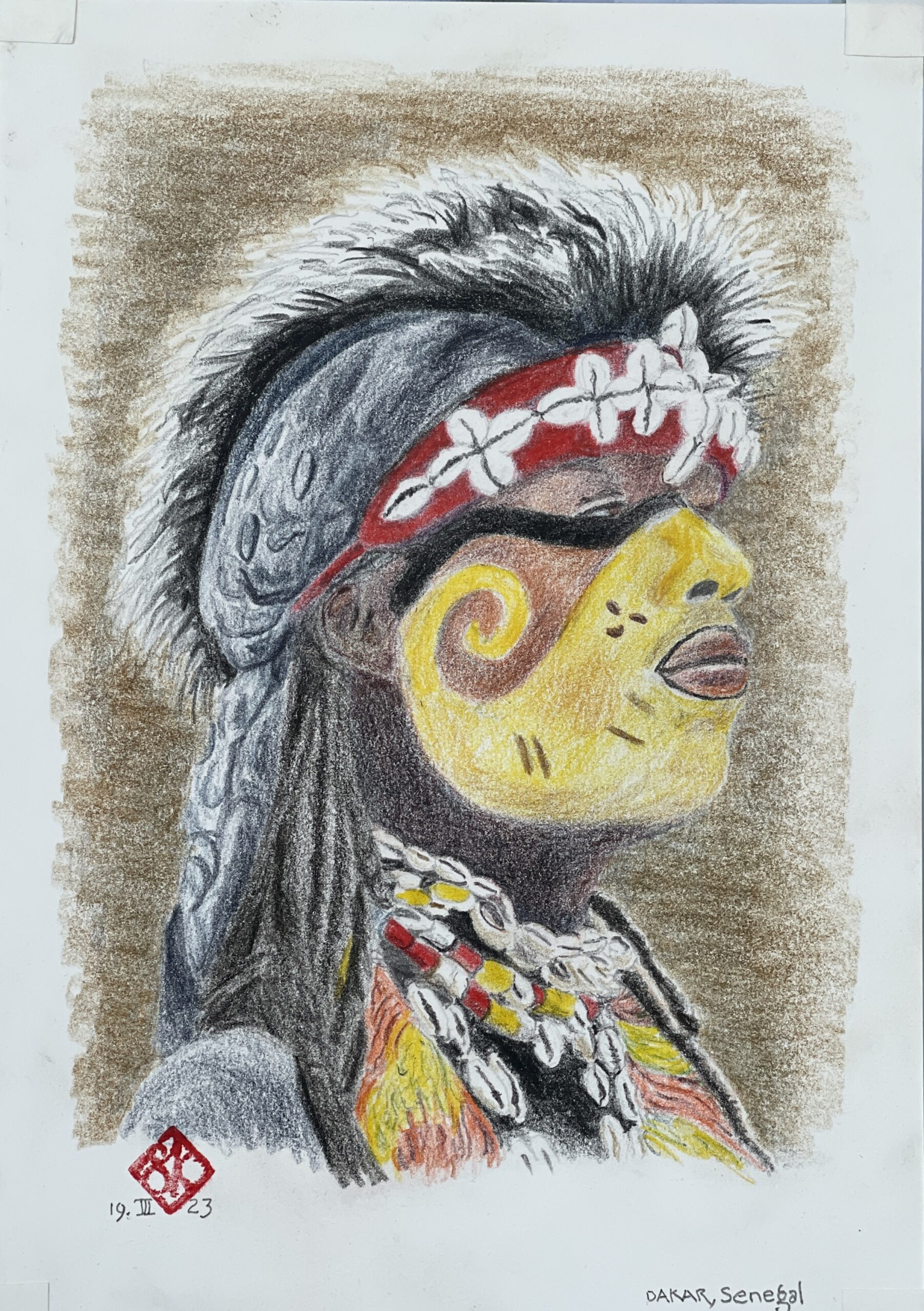Finished the first one-third of the cruise
DAY 61, Thursday, March 16. Mindelao, Cape Verde Islands
The name of these islands is as much of a misnomer as Greenland. It’s mostly rugged, jagged bare rock, covered with brownish gray dust, blown in from the Sahara. Some of the islands we passed on our way to the port looked uninhabitable, with no visible vegetation at all.
Mindelao is the capital and cultural center, we’re told, of Cape Verde. It’s a city of contrasts. In October (“Inktober”) I drew a picture from the Web of a Moorish looking building at the edge of the bay. To the left were some shade trees and a pavilion with people under it. I imagined a kind of picnic area. Well, in reality the area to the left serves as a landing place for small fishing boats, and those people under the pavilion are cleaning their fish. Cleaning fish is usually a messy business, and though I didn’t see any running water, I was surprised to see very little mess, and it didn’t smell bad, either. These folks knew what they were about.

Just a few blocks away, up a bit higher on the island, is a large, provincial-looking pink building, the presidential palace I guess you’d call it. The broad area in front was cordoned off and lined with red carpet. We found out that the president of nearby São Tomé and Principe was arriving for a state visit. Down from that, the white stucco of one side of an official building was just beginning to show some deterioration. Rather than let it go, as in many former colonial cities, an artist had rendered a stunning, two-story portrait of a local hero, the Grammy-winning singer Cesaria Évora. I hope to do a drawing of this; it will take some time to do it justice.
Leaving the Cape Verde Islands we were warned that between here and Capetown we will be traveling through an area where there is a danger of piracy, and that the ship is required to travel via a designated route that is monitored by the US and UK navies. At night the lights are reduced to a minimum, and we were warned about what to do if we encounter a pirate threat: leave the stateroom, stay low in the corridor. The last such attack was documented in 2019.
DAY 62, Friday, St. Patrick’s Day. At sea
As expected, the ship put on a celebration. Green hats and things were passed around, traditional Irish fare was offered in the restaurants.
DAY 63, Saturday, March 17. Dakar, Senegal.
Our first landing on the continent of Africa. Senegal, Dakar in particular, is considered to be one of the more modern places in this area of the world. For motor heads Dakar is known as the end point of the most famous—and deadly—cross-county race, the Paris-Dakar Rally.
We took a very popular all-day excursion (using three big buses) to the Pink Lake, and what they claim was the finish line of the rally, a platform on the shore of the lake, about a meter high, made of piled sand. As the last rally was held here in the early 2000’s, this and the brown/green color of the lake itself make me wonder. We were assured that under the right atmospheric conditions, at the right time of year, the surface of the lake does turn pink.
The drive to the lake took us through miles and miles of dusty streets lined with masonry-built two-story homes and shops, mostly partially finished! Mary and I have never seen so much construction going on. Our guide said these homes were built by people working in Dakar. The process of building a house here involves getting a small loan, building as much as possible with the loaned money, then getting another loan only after the first one was paid off. To me this tells me that this is not a society that is built on trust. The banks don’t trust their customers. Folks don’t trust the banks, or perhaps their government enough to save up enough to actually build a house.
Once we reached the lake we were loaded onto run-down 4×4 flatbed trucks with seats, 16 to a truck. They drove us up and across the “finish line” and to the edge of the lake, where people were waiting to sell us trinkets, and we saw the true nature of the lake. It’s actually a very old tidal pool. The water comes in from the sea and sits there, becoming more and more saline. The very edge of the water is covered with white foam, the salt. My understanding is that people scoop up this foam and simply let it dry, then sell it. We saw none of the flat areas that one sees in other sea-salt producing countries, though.
The trucks then launched across the surrounding dunes and took us to the ocean on a “thrilling ride.” I did not have confidence in our driver or the truck. It kept stalling out, and he had to pop the hood and prime the carburetor to get it started. I don’t know if it was his fault or the transmission that putting it into second gear was a continual struggle. At one point he had to get up out of his seat and step on some lever to get it to move–the four-wheel drive lever perhaps?
I was truly scared he would tip the truck over at any moment. It didn’t help that I was sitting over the right rear wheel, and the tire rubbed against the wooden floor under my feet every time he turned left, making a loud racket.
We were then taken to the nearby hotel where the big buses had dropped us off, for a “local feast.” Enough said.
The highlight, for me anyway, was a stop at a “village”—really a neighborhood in this urban sprawl—to see some dancing and hear some music. We tourists, all three buses worth, sat in plastic chairs lined up on the sides of a narrow, paved street. The music involved a battery of drummers putting out some cool syncopated beats and an incredibly amplified male singer singing a long, repetitive song that sounded to my ears very Arabic in style. Not like pop music from Egypt, say, but more like a call to prayer.
The dance was truly fun to watch. Four young men, one tall skinny guy dressed in long colorful robes, and three very muscular guys done up as lions, only the manes weren’t circular, but Mohawks. Their dancing involved lots of leaping and athleticism. At one point a number of women came dancing down the street. Six matrons in mu-mu’s and one young woman in a form-fitting dress. Her moves were more suggestive than that of the matrons.

I think it’s worth mentioning our surprise at the weather. The only time we felt hot during these three days in Africa and African waters was sitting in the sun watching the dance performance. Even then it wasn’t as hot as we expected.
